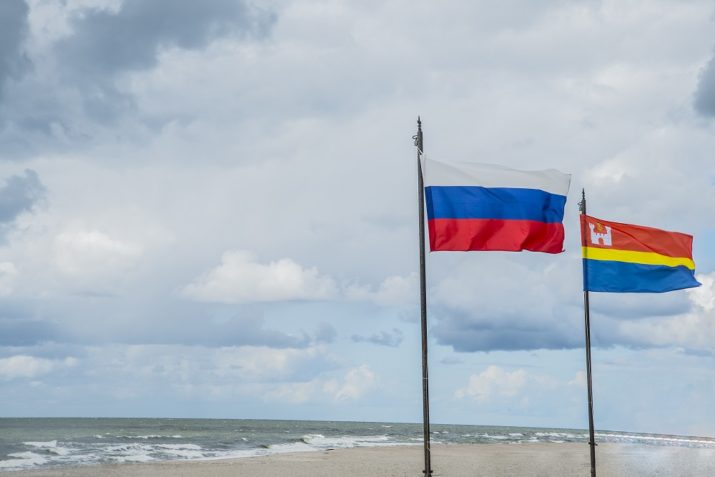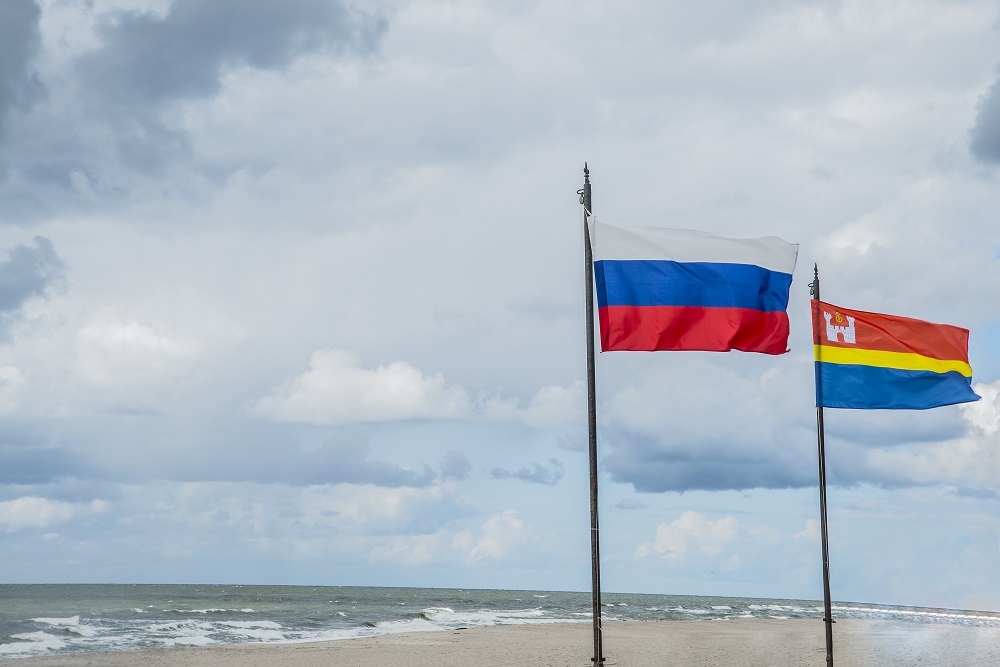

This is part of our special feature, Diversity, Security, Mobility: Challenges for Eastern Europe.
The case of Kaliningrad Oblast – the westernmost region of the Russian Federation physically detached from the mainland – should be seen as one of the most disappointing examples of post-Soviet transformation. Wielding close-to-perfect geopolitics and rich historical background, the oblast has failed to meet expectations of many domestic and foreign intellectuals, who had imagined Kaliningrad’s future to be prosperous and peaceful. On the other hand, the European Union (EU) acting via TACIS, “Euro region” initiative, Northern Dimension, attempted to help the region in overcoming the burden of its uneasy past (associated with almost complete isolation) and challenging present, stipulated by an arduous process of post-Soviet transformation. As a result, aside from sizable economic support, the oblast was given a unique opportunity to establish “very-close-to-special” type of relationships with the West – a prospect that was hardly conceivable in terms of the rest of Russia. Had this materialized (even in part) it would have drastically altered the essence of relations between Moscow and Brussels brining their communication to a qualitatively new level.
Regretfully, those were merely unfulfilled dreams. From 1996 on,[1] growing domestic conservatism coupled with aggressive populism signified re-orientation of Russian political discourse away from Liberal Institutionalism of the early 1990s toward neo-Eurasianist ideology. Neo-imperial nationalism that started to dominate Russian foreign policy thinking from the late 1990s,[2] continuing fear of separatism and growing paranoia over NATO’s eastward enlargement had profound and far-reaching consequences for the future of Kaliningrad.
Kaliningrad at the crossroad of history: why the “golden cage” nostalgia prevailed?
Throughout the Soviet period (with the exception of the first 10-15 years), history of Kaliningrad Oblast was shaped by some sort of “duality.” On the one hand, an unprecedented extent of its militarization and artificial isolation imposed by the Soviet regime turned the oblast into some sort of a “garrison state.”[3] At the same time, life in the oblast was not the same as in the rest of the USSR. Availability of western goods, the lack of notorious “deficit” and huge economic subsidies from the centre as a “compensation” for challenging history, made lives of an average local dweller different from one had to have in the mainland. This created an illusion of stability and security, shielding the locals form ugliness of the Soviet routine. In a sense, this made the oblast a “privileged” part of the vast USSR, simultaneously making it one of the most desirable targets for internal migration.
The relative comfort and stability were destroyed in the early 1990s, when the oblast had to face the real world. The dissolution of the USSR cut it off the mainland by borders of newly emerged countries, destroying existing economic model and making communication with the rest of the Russian Federation more difficult. Consequently, the immediate shock of these transformations resulted in an economic shock that surpassed the one experienced by the rest of Russia. Despite the severity of the crisis, Moscow was unable/unwilling to work on a concrete strategy of economic reforms that would have alleviated consequences of this crisis. Meanwhile, being reluctant about the so-called “Kaliningrad question,” the Kremlin felt ill at ease with European countries taking a more active role in the fate of the oblast, being suspicious of either local separatism or external irredentism. From their part, the Europeans also had no interest in meddling in Kaliningrad internal affairs in order not to provoke Russia.
In the end, the lack of agreement and cohesive actions backfired on Kaliningrad. Within just several years, the oblast received such nicknames as “Russia’s HIV capital” and the “black hole of Europe”[4] – status that irritated the locals, embarrassed the Kremlin and disturbed the Europeans. The economic collapse in 1998 became the last drop – the local elites openly appealed to Moscow in search for solution of mounting (and seemingly irreconcilable) problems. With this, popular support for liberal reforms initiated in the early 1990s was melting down, along with the image of the West, with voices preaching for a “strong hand” becoming more audible. That is why the advent of young, energetic, and decisive Vladimir Putin with his promise of stability and order, was gladly embraced by the locals tired of hardships and envious of rapidly developing neighbours.[5] As it turned out, soon the price of “stability 2.0” had its dark flipside.
The “beacon” of the “Russian World”: Kaliningrad as a source of “soft” challenges.
The fateful transformation of Kaliningrad from a “periphery” to the “vanguard” of anti-Western sentiments was by no means something that happened over night. Rather, it should be seen as a complex and multi-layered phenomenon owed by its emergency to a constellation of internal and external factors. True, scepticism about the West and its role for Kaliningrad was present throughout the 1990s, yet those voices mostly emanated from marginalized groups being mute in comparison with general sentiments. However, with the lapse of time, anti-Western sentiments were no longer seen as something extraordinary. That gradual change of perception was precipitated by tectonic shifts that occurred within the interim from 1999 to 2004. The war in Yugoslavia, Western criticism of Russia over domestic affairs, NATO’s eastward “expansion”[6] and the enlargement of the EU (2004) – those events were increasingly presented by Russian propaganda as “unfriendly” gestures from the side of the West.[7]
First, a concrete attempt to use Kaliningrad Oblast as a venue for inflaming anti-European sentiments dates back to the year 2005, and was tinted into anti-Polish/Baltic colors. Encouraged by a tactical “success” (2003) and its aftermath,[8] Vladimir Putin decided to test the level of cohesion between the so-called “old” and “new” Europe. Prior to the 750th anniversary of Kaliningrad/Konigsberg, the Russian side demonstratively refused to send invitations to the leaders of three Baltic States and Poland, explaining this as “anti-Russian policies” and “Russophobia” reigning in these countries.[9] The gesture, however, was not appreciated by France or Germany, which to some extent puzzled the Kremlin. Russian leadership had pinned profound hopes on growing economic cooperation with major EU members (Germany in particular) that would, -according to Russia’s political leadership, – allow it to continue its country-to-country approach while dealing with the EU. This tactical defeat did not dissuade Russia from further actions in the same direction. At this juncture, it was the year 2007, characterized by two critical developments that had a particularly instrumental meaning for Kaliningrad. First, the emergence of the “Russian World” project (2007) and its subsequent expansion beyond initially identified boundaries; secondly, Russia’s growing interest in so-called Russian “compatriots abroad,” who, according to the Kremlin’s expectations, were supposed to move from the Baltic States to Kaliningrad Oblast. In spite of huge hopes (in part generated due to the lack of credible information about living standards in these countries), the initiative suffered a humiliating defeat. Buoyant prognoses of the local governor Georgy Boos (handpicked by Putin for the position) did not play out at all; the oblast managed to attract negligible number of settlers, many of whom left the oblast after a while. This vividly demonstrated the true gap in terms of economic development between the EU’s “poorest” members and “prosperous” Kaliningrad. All in all, within 2000-2013, Moscow was hardly able to use Kaliningrad in terms of anti-Western propaganda. It was the Ukrainian crisis that became a gamechanger. Within 2014-2016, the oblast (and its perception by Moscow) underwent transformation that not only made it the beacon of the “Russian World” project, yet also turned it into the “ideological battlefield” between Russia and the West.
These developments were reflected in the following:
1. War on the past. The best definition of the way the Soviets handed German cultural legacy after 1945 in Kaliningrad/Konigsberg, is “barbarism.” Regretfully, the task that was not finished by the Communists was “successfully” taken over by the Russian Orthodox Church (ROC). Due to its mismanagement, many pieces of German architecture have come to the brink of complete decoy.[10] The tone of this disgraceful enterprise was set by Patriarch Kirill himself, who defined German architecture remaining in the oblast as “old stones” and preached for “development of Russian cultural traditions.”[11] In case this trend continues, the remnants of cultural landscape still present in the oblast will be completely extinguished;
2. Disinformation assault against Poland. With events in Ukraine, this country became one of the prime targets of Russian (dis)information campaign. The start was given by the local governor Nikolay Tsukanov (to be later promoted by President Putin to the position of plenipotentiary envoy to the Northwestern Federal District) and local information outlets that accused Poland for “preparing Maidan in Kaliningrad;”[12]
3. The “crusade” against Lithuania. Vilnius became the next target. Within several months, Russian media (the example was set again by Tsukanov) produced an avalanche of material about “poverty” and “depopulation” of Lithuania, which directly stemmed from membership in the EU and “economic colonization” of the country. Another event greater magnitude occurred in Vilnius in the end of 2016. The Russian Embassy disseminated leaflets that called on the local population to abandon Lithuania because of “detrimental economic conditions”[13] and to move to Kaliningrad. When confronted by the Lithuanian side, the Embassy acknowledged its role in this ugly event (without any apologies however) thus de-facto admitting interference in internal affairs of a sovereign country;
4. The new lap of witch-hunt. Since emergence of the term “foreign agent” (2012), pressure on independent NGO`s in Russia has increased exponentially. Russian reading of this term goes hand in glow with such notions as “fifth column” and “western spy.” In Kaliningrad, the most well-known victim became the oldest and one of the most influential foreign NGOs the “German-Russian House” that was implicitly accused of “popularization of Nazi ideology.”
Taken together, those developments have been eloquently summarised by Igor Nikolaychuk, the head of the Department of Regional Security Problems at the Russian Institute for Strategic Studies, who during his stay in Kaliningrad stated that the oblast would never become a demilitarized “region of peace.” This being said, one could argue that the image of progress achieved after 1991, has been almost extinguished within a shockingly short interim, making one wonder whether there was any progress at all.
At the forefront of Russian military might: a call from the past or a new daunting reality?
The fact that prior to the year 1991 Kaliningrad Oblast was a secluded entity hedged from its neighbors, did limit its future employment as an “ideological bastion.” Conversely, in security-related domains, the oblast could “boast” with its background. This, however, became largely obsolete in the beginning of 1990s when the Treaty on Conventional Armed Forces in Europe (CFE), coupled with decreasing military spending, slashed the former military potential of the oblast. Many analysists, intellectuals, and practitioners welcomed this new reality as a forbearer of full de-militarization of the entire Baltic Sea region. This however was merely a veneer of change, a mirage that would be dispelled before long.
Indeed, on the surface, it might seem that the process of de-militarization of Kaliningrad occurred within a very brief interim, greatly owing to the events in Ukraine after 2014. This is only half truth. In effect, if one takes a look at the period from 1996 to 2003,[14] it would be possible to spot a great number of alarming signals, tendencies, and developments that testified for Russia’s changing approach to the oblast in military-strategic terms.
In the range of events, it would not be a mistake to identify the year 2007 as truly decisive, which was based on two main aspects. First, the (in)famous speech of President Putin in Munich ushered in an era of new political reality that came to be known as “cold peace.” Secondly, Russia’s decision to “suspend” its participation in the CEF unambiguously pointed approaching militarization. These developments had an immediate and at the same time far-reaching effect on Kaliningrad Oblast.
Starting from 2008, Russia increased its blackmail of the Europeans relying on “Iskander diplomacy”[15] – a threat to deploy mobile nuclear capable “Iskander-M” complexes (killing range of up to 500 km) on the territory of Kaliningrad. Within 2008 – 2014, these threats were increasing proportionately to the growth of arguments between Moscow and its foreign partners. Secondly, in 2009, Kaliningrad co-hosted Russia-led strategic operational war games under the code name “Zapad,” resurrecting the Soviet military tradition. The most distinctive feature of the event (aside from its scope in comparison with “Zapad-1999”) was the fact that the games simulated a military attack against Poland, which alarmed not only Warsaw, but the entire North-Atlantic Alliance. This, however, was not the end of story. The next “Zapad” that took place in 2013, was to become the largest strategic-operational war games on the post-Soviet space since the pre-1991 period dwarfing previously held event. Military analysists have argued that the number of military personnel employed may have varied from 70,000 to staggering 100,000.[16] Undoubtfully, increasing quantitative and qualitative scopes of such war games were hardly compatible with official Russian rhetoric about continuing partnership with the EU.
Indeed, it was the Ukrainian crisis that had the most dramatic effect on the pace, scope, and direction of Russian military build-up. Moreover, it gave Moscow an appropriate “justification” for launching a new lap of militarization, which in fact had already been underway for several years. This pretext – allegedly “unfriendly” policies of NATO and its European allies (irrespectively of Russia`s role in the annexed Crimea and events on the Ukrainian Southeast) – enabled the Russian side to finally walk out of the CEF Treaty (March 2015) thus embarking on a campaign of uncontrollable militarization. Kaliningrad found itself in the middle of confrontation, becoming a showcase testifying for Russia´s militarization capabilities.
Within 2015-2017, the oblast was packed with formidable and most up-to-date weaponry such as “Iskander-M” complexes, the S-400 Triumf (SA-21 “Growler”) surface-to-air missile system, Bal (SSC-6 “Sennight”) and K-300P Bastion-P (SS-C-5 “Stooge”) costal missile complexes equipped with P-800 “Oniks” (SS-N-26 “Strobile”) that can target objects at a 600-km distance. By doing this, Moscow keeps the door open for the deployment of the S-500 Prometey (55R6M “Triumfator-M”) surface-to-air missile system that are said to be capable of destroying stealth warplanes like the F-22, F-35 and the B-2, and a number of other pieces. As a result of these measures, Kaliningrad Oblast has been turned into Russia’s formidable Anti-Access/Area-Denial (A2/AD) “bubble”[17] thus jeopardizing regional peace and security. At the same time, Russian aggressive rhetoric boosted with no less assertive actions (such as provocations with the use of submarines and fighting jets) have alarmed traditionally peaceful Sweden and Finland, where talks about joining NATO are becoming more articulate. This collides with yet another portion of Russian threats directed against Stockholm and Helsinki, leading toward a dangerous impasse.
The most recent transformation that has befallen the Baltic Sea region – one of the most dynamically developing entities in the world in terms of economic performance and cross-border cooperation – are indeed unpleasant and troublesome. As a result, the area is now rapidly turning into the new “powder keg” of Europe.[18] The most gruesome aspect of this metamorphosis is inseparable from the role of Kaliningrad. The birthplace of brilliant German philosopher Immanuel Kant, not-so-long-ago promising to become Russian “response to Hong Kong”, the oblast is now painfully resembling its historical predecessor – a heavily militarized, isolated and centre-dependent entity. Unfortunately, the example of Kaliningrad Oblast has once again vividly demonstrated that Russian political leadership still lives in an illusory world built on patterns more commensurate with power politics of the cold war than the post-1991 world order.
Sergey Sukhankin is an Associate Expert at the International Centre for Policy Studies in Kyiv and a Visiting Scholar at IBEI in Barcelona. His areas of interest include political and economic developments as well as security-related issues in the countries of the former Soviet Union, with an emphasis on the Baltic Sea region (Kaliningrad Oblast in particular). His area of scientific expertise also includes topics related to cyber security, Electronic Warfare (EW) and Russian military thought. Scientific articles, policy papers, commentaries and expert opinions by Sergey have frequently appeared in such high-profile European think-tanks as CIDOB (Barcelona), European Council on Foreign Relations (London), ICPS (Ukraine), Diplomaatia (Tallinn) and New Eastern Europe (Poland). He is also a weekly contributor to the Jamestown Foundation (Washington DC) on security-related issues and developments in the Baltic Sea region.
Photo: Russian Federation tricolor of Kaliningrad Oblast against blue sky with clouds | Shutterstock
References:
[1] When liberally-minded Russia´s foreign minister Andrey Kozyrev was replaced by conservative Yevgeny Primakov.
[2] S. Sukhankin. Russia for Russians! Ultranationalism and xenophobia in Russia: from marginality to state promoted philosophy. Notes Internacionals, CIDOB (Barcelona), No. 128, September 2015. Available at: https://www.cidob.org/ca/publicacions/series_de_publicacio/notes_internacionals/n1_128_russia_for_russians/russia_for_russians
[3] For more information see: A. Sergounin. Kaliningrad: Russian Outpost or Window on Europe? Nizhny Novgorod Linguistic University, Russia, 2003.
[4] S. Sukhankin. Kaliningrad: Baltic Hong Kong No Longer. Baltic Bulletin, Foreign Policy Research Institute (Philadelphia), April 26, 2017. Available at: https://www.fpri.org/article/2017/04/kaliningrad-baltic-hong-kong-no-longer/
[5] S. Sukhankin. Kaliningrad: Russia’s island in Europe. New Eastern Europe (Cracow), 29.01.2016. Available at: http://www.neweasterneurope.eu/interviews/1876-kaliningrad-russia-s-island-in-europe
[6] In Russian political vocabulary the term “enlargement” is usually replaced by “expansion”, which drastically alters the essence.
[7] S. Sukhankin. The “Trump cards” of the Russian Propaganda and Disinformation Operations. Notes Internacionals, CIDOB (Barcelona), No. 176, June 2017. Available at: https://www.cidob.org/es/publicaciones/serie_de_publicacion/notes_internacionals/n1_176/the_trump_cards_of_the_russian_propaganda_and_disinformation_operations
[8] When Germany, France, Spain and China sided with Moscow criticizing US incursion of Iraq. This was also accompanied with a series of frictions between Poland and certain EU member states.
[9] It should be remembered that it was Lithuania to first offer Kaliningrad economic assistance in 1998, when the oblast came to the brink of economic collapse, whereas Poland had
[10] For more information see: S. Sukhankin. The “Russkij mir” as Mission: Kaliningrad between the “altar” and the “throne” 2009-2015.Research Paper, Magazine Ortodoxia, University of Eastern Finland, 2016.
[11] Выступление Святейшего Патриарха Кирилла на I Калининградском форуме Всемирного русского народного собора. 14.03.2015. Available at: http://www.patriarchia.ru/db/text/4013160.html
[12] Цуканов: Западные спецслужбы хотят «раскачать» майдан в Калининградской области. 01.07.2014. Available at: http://kgd.ru/news/society/item/36414-cukanov-zapadnye-specsluzhby-hotyat-raskachat-majdan-v-kaliningradskoj-oblasti
[13] S. Sukhankin. Lithuania: The Old-New Target of Russian ‘Hybrid Warfare?’ The Jamestown Foundation (Washington DC), January 27, 2017. Available at: https://jamestown.org/lithuania-old-new-target-russian-hybrid-warfare/
[14] S. Sukhankin. The Kaliningrad Oblast Today: A “Military Bastion 2.0”, not a “Bridge of Cooperation”. Diplomaatia (Tallinn), No. 165, May 2017. Available at: https://www.diplomaatia.ee/en/article/the-kaliningrad-oblast-today-a-military-bastion-20-not-a-bridge-of-cooperation/
[15] S. Sukhankin. Russia Flexes ‘Iskander’ Muscles on Its Northwestern Flank. The Jamestown Foundation (Washington DC), Eurasia Daily Monitor Volume: 13 Issue: 163, October 12, 2016. Available at: https://jamestown.org/program/russia-flexes-iskander-muscles-northwestern-flank/
[16] For more information see: Russia’s Zapad 2013 Military Exercise. Lessons for Baltic Regional Security. The Jamestown Foundation (Washington, DC), December 2015. Available at: https://jamestown.org/wp-content/uploads/2015/12/Zapad-2013-Full-online-final.pdf
[17] S. Sukhankin. Kaliningrad oblast – Russia`s formidable A2/AD bubble. New Eastern Europe (Cracow), 02.08.2017. Available at: http://neweasterneurope.eu/articles-and-commentary/2450-kaliningrad-oblast-russia-s-formidable-a2-ad-bubble
[18] S. Sukhankin. The Baltic Sea Region: A New ‘Powder Keg?’. The Jamestown Foundation (Washington DC), Eurasia Daily Monitor Volume: 13 Issue: 90, May 9, 2016. Available at: https://jamestown.org/program/the-baltic-sea-region-a-new-powder-keg/
Published on December 6, 2017.




